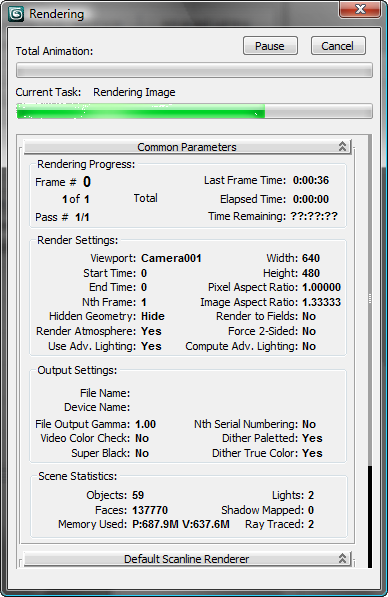This section addresses several common user-interface situations and how you can fix them.
It can be frustrating when you can't find something on the user interface, especially when you saw it a few minutes ago and now it's gone missing. Of course, you've been so engrossed in your modeling that you forget what you might have done to cause the button, element, or dialog to disappear. Here are fixes for some of these situations.
Multiple or Missing Buttons on the Toolbars
3ds Max is set up to use small fonts, which are the default for Windows. If you use large fonts, you might see some anomalies in the 3ds Max interface:
To remedy these problems, set your system font back to smaller fonts.
Set system to default fonts (Windows XP):
 Settings
Settings  Control Panel, and click Display.
Control Panel, and click Display.
You can also right-click anywhere on the open desktop and choose Properties.
You have to reboot the system for the font size change to take effect.
Set system to default fonts (Vista):
 Control Panel.
Control Panel.
 Optimize Visual Display.
Optimize Visual Display.
 Change The Size Of Text And Icons.
Change The Size Of Text And Icons.
Set system to default fonts (Windows 7):
 Control Panel.
Control Panel.
 Optimize Visual Display.
Optimize Visual Display.
 Change The Size Of Text And Icons.
Change The Size Of Text And Icons.
3ds Max has many dialogs or windows that float when you open them. This feature allows you to drag them anywhere on your desktop. You can greatly improve your design efficiency by positioning dialogs out of the way of the main 3ds Max interface; for example, on a second monitor if you are set up to use two monitors.
However, there are times when a dialog gets lost. Either you drag it someplace and inadvertently let go of it, or some data is written incorrectly to an initialization file and you end up with a lost dialog.
There are a couple of ways to recover a lost dialog; both entail working with the 3dsmax.ini file.
In this example, let's say you've got a single monitor that's configured for 1280x1024 resolution and you've lost your Rendering Progress dialog.

It was visible the last time you rendered, but that was a while ago and someone else has been using the system.
The 3dsmax.ini file is constantly being updated while 3ds Max is running.
On Windows XP, by default 3dsmax.ini is located in the program folder. On Vista and Windows 7, by default it is located in \users\<username>\appdata\local\autodesk\3dsmax 2012\enu\ (or "3dsmaxdesign" for 3ds Max Design, and "3dsmax 2012 - 64bit" for the 64-bit version).
If you can't find 3dsmax.ini in the default location, you can use the Windows Search function to locate it.
[RenderProgressDialogPosition] Dimension=-425 152 379 866
The first two Dimension digits specify the location of the upper-left corner of the dialog, relative to (0,0), which is the upper-left corner of the screen. Therefore, in this example, the upper-left corner of the dialog is –425 pixels from the left edge of the screen and 152 pixels from the top. The second pair of digits describe the horizontal and vertical size of the dialog, so this dialog is 379 pixels wide and 866 pixels tall.
Since this example assumes a single monitor, configured for 1280x1024 resolution, this dialog is off-screen to the left. If the first number were greater than 1280, the dialog would be off-screen to the right.
The problem number is usually the first or second, since the last two set the width and height of the dialog.
The next time you render, the Rendering Progress dialog appears appear on-screen.
This is the preferred method, because it causes no loss to other custom configuration settings that are stored in the 3dsmax.ini file.
There are really only two reasons you'd use this method:
3ds Max creates a new 3dsmax.ini file that uses the default settings.
You need to be careful when using this method, because you don't necessarily know what custom settings are saved in the 3dsmax.ini file. Perhaps you have 3ds Max set to display the command panel on the left and you've changed the viewport background color. Furthermore, if you have third-party plug-ins installed, they sometimes write information to 3dsmax.ini. If you delete the file, you lose those changes.
If you're not sure about customized settings that are stored in 3dsmax.ini, you can rename the file to something like old3ds.ini. When you restart 3ds Max, you can continue working and, at a later time, compare the two files and copy the data you need from the old one to the new one.
The command panel normally appears along the right side on the user interface. If you start 3ds Max and notice that the command panel is missing, there are usually three causes.
All of these situations can be quickly fixed by using the following steps.
Whenever you move, rotate, or scale an object, the red axis tripod is replaced by a special-purpose transform gizmo. It's possible to lose the transform gizmo, but it's easy to get it back. If you find you've lost your transform gizmo, try these steps:
This is the keyboard shortcut that toggles the transform gizmo on and off.
This keyboard shortcut increases the size of the transform gizmo. The – key reduces the size.
 Preferences
Preferences  Gizmos panel, and match your setting to the default settings shown in the following image.
Gizmos panel, and match your setting to the default settings shown in the following image. 
Multiple or Missing Buttons on the Toolbars
This is another tricky situation. You open a toolbar and find that there are duplicate buttons present or the button you expect to find is no longer there.

Three Select And Move buttons
This is clearly a user-interface problem, so reverting to the startup layout will fix this problem.
If you have multiple buttons and don't want to reset the entire UI, you can remove duplicate buttons manually by doing the following: